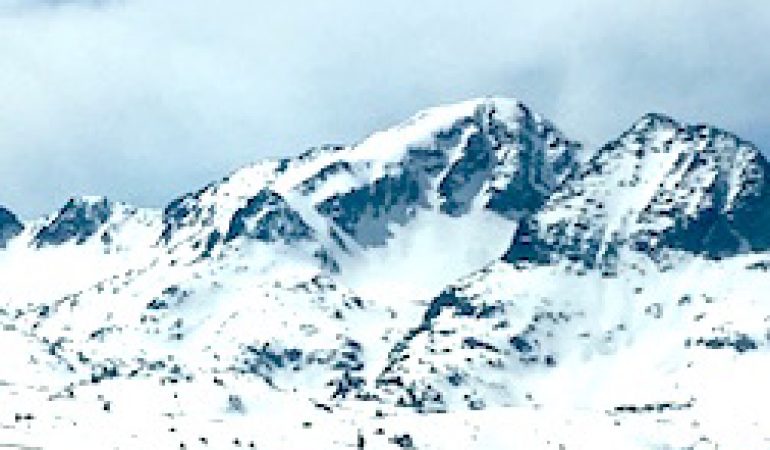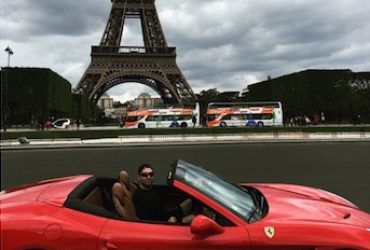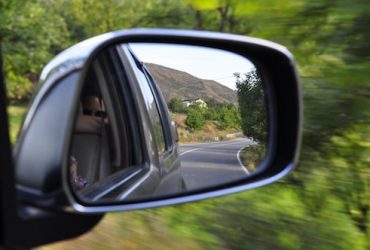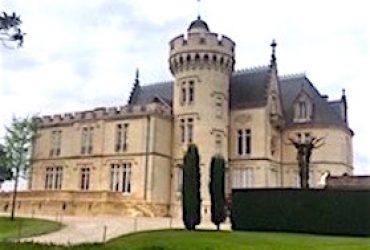Road Trip 3: Toulouse to Andorra and Back
The third road trip I did in France was actually to go visit the tiny European micro-state of Andorra. Perched high up in the Pyrenees Mountains that form the natural border between France and Spain, Andorra is a sovereign independent nation that is strangely but officially headed by two foreign office-holders – the President of France and the Spanish Bishop of Urgell – who each hold the unique title of Co-Prince of Andorra.

Andorra is perched high in the Pyrenees Mountains, so it’s snowy even in April.
NOTE: This is part 4 in a multi-part series on road tripping in France. Be sure to check out the other parts detailing other French road trips linked below. And definitely don’t miss the awesome dashboard video montage I compiled of me road tripping across the French countryside, linked below here and also following each article in this series.
Andorra is not a member of the European Union or the Schengen Zone, unlike its neighbors who spoon it. Instead, Andorra is known as a famous tax haven to stash your cash and an incredibly cheap place to shop tax-free. Seriously, I was so shocked by how cheap things were in Andorra that I bought an entire suitcase full of name brand alcohol to restock my bar back home and it only cost me about $120 – for an entire large suitcase full of huge bottles of booze. It came to about one-third the price of the same selection of bottles back home or even elsewhere in Europe.
So you can surely see why Europeans just love going to Andorra to shop. They also love to go there to bank and ski, but other than that there’s not much more to the country. However, I’ve had a fascination with micro-states since I was a youngster, so I just had to take advantage of being only three hours away from Andorra on one particular trip to France and decided rent a car and make the journey up into the Pyrenees for a visit.
I picked up a rental car from the Avis location at the Toulouse airport – which is SO easy to access from downtown by tram, by the way – and headed back downtown to pick up my two friends, Tina and Rajiv, with whom I had also previously done the Tour de Bordeaux road trip. We loaded up the car, popped “Andorra” into the GPS, and set out for our next road trip adventure.
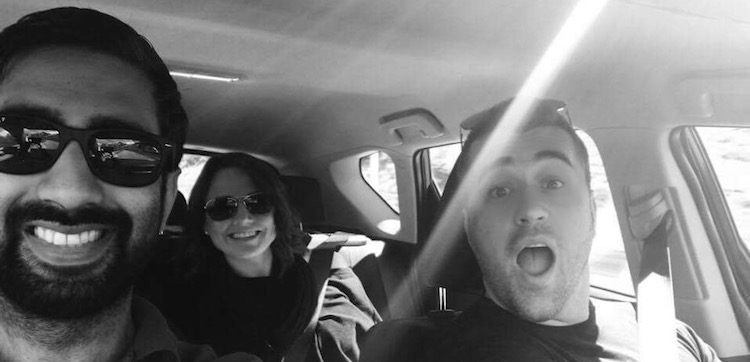
Car is gassed up and we’re all ready for our road trip to Andorra.
Leaving Toulouse and heading south or southeast is always a beautiful drive because the Pyrenees Mountains quickly come into view in the distance with combinations of rolling hills, green fields, and vineyards in the foreground. We opted for the highway route out of Toulouse since our objective here was to get to Andorra as quickly as possible and spend time there. But we only had to spend about an hour on highways before the route changed to smaller country roads through quaint little midi-Pyrenees towns and villages that dot the foothills of the Pyrenees range.
The drive through this rural area was pretty simple and straight forward. There wasn’t a lot of traffic, but we added an extra half hour to our journey by stopping at a McDonald’s for breakfast, which took a good 20 minutes to prepare. This was actually the second time I experienced a significant delay on a road trip in France because of a McDonald’s breakfast stop, the other time being en route to Bordeaux.
The easy drive through rural southern France turned a little harrowing and treacherous, however, as we got into the Pyrenees and approached Andorra. Andorra is smack dab in the middle of the range, so you have to drive into the heart of the high mountain chain to get to the country’s borders. And it’s not like they can just blast tunnels through all the mountains to get you there. Andorra super high up, so you have to actually ascend in order to get there.
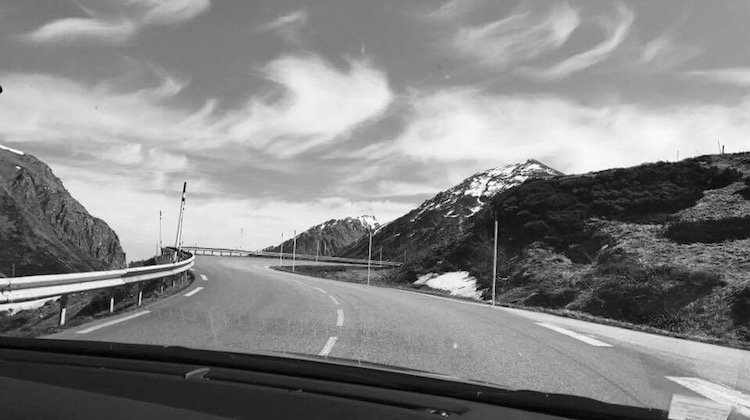
I figured I’d made this one black and white too for dramatic effect… kind of like a Hitchcock film.
This is where the harrowing part comes in. The approach to Andorra from France is windy – not windy as in with blowing wind, but windy with winding roads… severely winding, as in like 180-degree cut-back after 180-degree cut-back after 180-degree cut-back after 180-degree cut-back. Pictures can’t do justice to the total experience of ascending a super narrow, winding, steep-drop-off road all while your ears are popping and you’re wondering why so many people put themselves through this just for a little money laundering and shopping.
Ok, it wasn’t quite that bad if you’re actually driven windy mountain passes before, but it was also the middle of summer. I simply cannot imagine driving that route in the dead of winter with icy roads and snow coming down. But people do it, and if you want to go to Andorra you just have to. There are no airports or train stations there, so it’s either car or bus to get there… on those high-altitude switch-back roads. And since skiing is a major attraction for Andorra, I’m guessing lots of people just suck it up and make the drive in the winter. More power to them. Must be some damn great skiing.
Once we got to the border, it was easy breezy to get into the country. As I mentioned earlier, Andorra is not in the European Union nor in the Schengen Zone, and countries that aren’t in both of those usually have strict border control. But since the two countries that sandwich Andorra are both in both of those unions, Andorra feels pretty safe having waive-through border checkpoints on the roads leading into its territory.
Once we crossed the French-Andorran border, we still had a little ways to go until we got to Andorra’s capital, which is called Andorra la Vella. There are a few little villages – if you can call them that – before you get to the capital, but the road in from France, which is north of the country, takes you all the way around to the eastern side of Andorra near the Spanish border before it actually crosses the border into Andorra. And Andorra la Vella is about three-fourths the way across the country in the west, although we’re still talking about a micro-state here so it’s only about 20 minutes to make the drive even on small mountain roads.
Andorra la Vella is definitely a cute little town. And because it’s a banking hub (cough cough) and a tax-free shopping hub, it actually has a fair amount of stores, restaurants, and shops throughout the town. We drove around the whole capital in about 10 minutes and found a parking garage in a central area from which we could set out on foot and explore.

Cute little buildings in Andorra la Vella, including their Parliament at left.
We did the tourist thing for about 30 minutes, walking around and snapping pictures of quaint mountainside buildings, a church or two, the parliament building (which naturally looked more like a city hall), and a few quaint vistas across the hilly capital. With that out of the way, we then plopped down for lunch, which afforded us the first opportunity to interact with real Andorrans.
I was kind of surprised to hear them speaking Spanish, since I had been hearing French for quite a while and just assumed that they would speak more French than Spanish. I don’t know why I thought that, but I did. But for the Andorrans with which we interacted, Spanish was the default, although I’m sure they spoke French too. I don’t speak French but I do speak Spanish, so this was a nice surprise. And actually, French, Spanish, and Catalan are all three the official languages of Andorra, and it’s the only country in the world where Catalan is an official language.
After our sightseeing, lunch, and unexpected shopping splurge after realizing how cheap everything was in Andorra, we loaded up the car with our purchases (nearly all booze) and headed back for the three-hour drive to Toulouse. I really wanted an Andorran passport stamp and planned to ask for one at the border crossing, but they waved us through so quickly that I didn’t even have the chance. So we had to go park on the French side of the border, walk back into Andorra, go into the border control office, and ask for the stamp. The immigration guy happily obliged, albeit with a little chuckle.
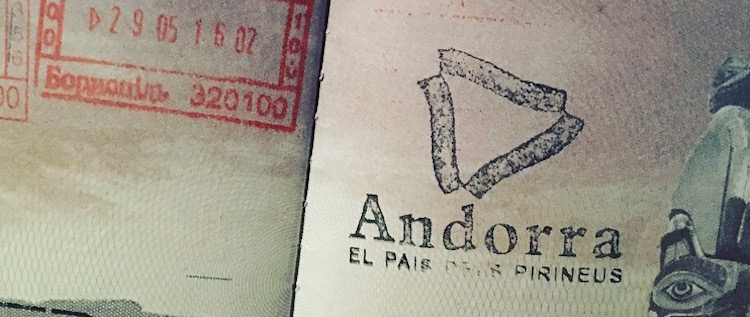
Another passport stamp from another elusive micro-state in Europe.
And with that, we were off for the return journey back down those windy, 180-degree switchback roads we had come up. It seemed less nerve-racking going back down them, but you better have good breaks or else. Once we got out of the Pyrenees, we opted for a slightly different route of rural roads to get back to the main highways leading to Toulouse, which afforded us some even better scenery than we found on the way in.
A couple hours later we were back in the big city and I was returning the car to Avis just as quickly and easily as I had picked it up. I’ve found that renting cars in Europe is just as easy if not easier than doing so in North America. Once in a while, you’ll get a rental car place that takes longer than necessary to get you out the door, but that’s the same back home too.
The key is to be signed up as a frequent renter, have a credit card on file, and even accumulate some status through frequent rentals with the same company if you can. Then it’s pretty simple to reserve a car in Europe, go pick it up, and be on your way to some awesome sites and scenery outside of the main cities.
Other Featured Road Trips Across France:
-
Road Trippin’ Across France – Intro
-
Road Trip 1: Paris to Monaco
-
Road Trip 2: Tour de Bordeaux
-
Road Trip 3: Toulouse to Andorra and Back
-
Road Trip 4: Toulouse to Nice
